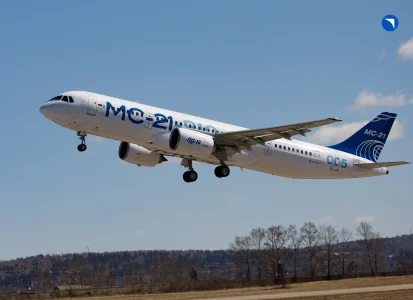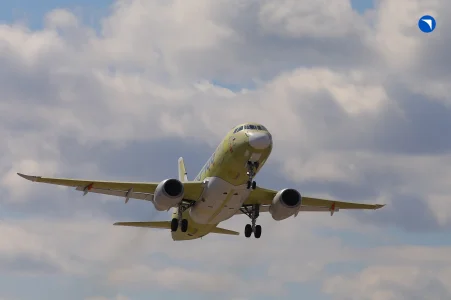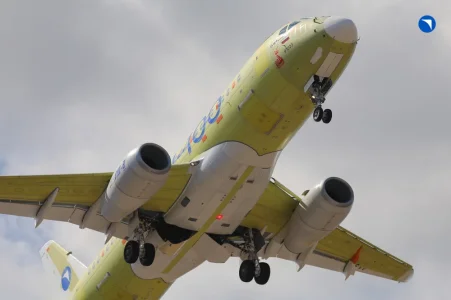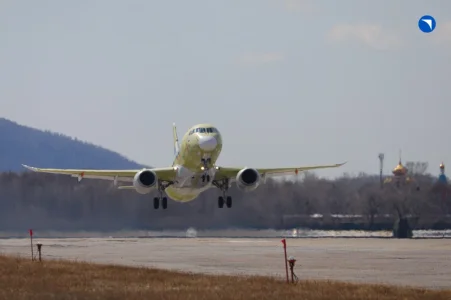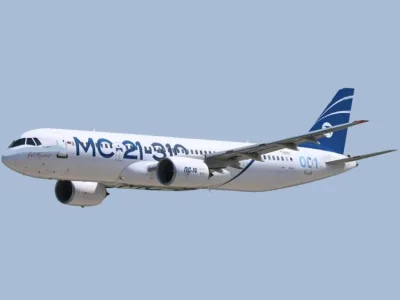MS-21 – April 2025 digest
03.05.2025, 11:57
Photo from the Yak-130 escort aircraft. © IAZ test pilot D. Denisov / Provided by the press service of PJSC UAC
The first flight of the import-substituted MS-21-310 with tail number 73055 became the key event of the month. The aircraft took off on April 29 from the airfield of the Irkutsk Aviation Plant. The crew, consisting of the commander, test pilot, flight test director of PJSC Yakovlev Roman Taskaev, test pilot of PJSC Yakovlev Alexander Guskov, as well as leading flight test engineers of PJSC Yakovlev Alexander Popov and Alexander Solovyov, spent 1 hour and 15 minutes in the sky. The flight took place at altitudes of up to 3,000 meters, and a speed of 580 km/h was reached. During the first flight, the MS-21 was accompanied by a Yak-130 aircraft, from which the filming was carried out. The Yak-130 was piloted by PJSC Yakovlev test pilot, Hero of Russia Oleg Mutovin, and the filming was conducted by Irkutsk Aviation Plant test pilot Dmitry Denisov. During the flight, the MS-21-310 crew checked the operability of domestic onboard radio-electronic equipment (avionics), power supply systems, air conditioning and some others. After completing the factory development tests, the aircraft will return to Zhukovsky to undergo certification tests.
The Gagarin Komsomolsk-on-Amur Aviation Plant (KnAAZ) is upgrading its pressing equipment to speed up the production of skins for the MS-21. Previously, these parts were manufactured in Ulyanovsk at the Aviastar plant, but now production has been moved to the Far East. When mastering a new production, each skin requires an individual approach. Such work is rarely carried out, usually when launching new models. The last time something like this happened was when creating the Superjet eight years ago.
The difficulty in mastering the process of forming the MS-21 skin blanks was that KnAAZ and Aviastar use different presses. Because of this, the tooling transferred by Aviastar was not suitable. Engineer Anton Krivenok found solutions for manufacturing the skins, but they were not the most optimal. In connection with this and the tight development deadlines, an agreement was signed with the engineering company "ITS", whose specialists prepared programs for six skins and proposed improvements in the molding technology.
The transfer of skin production to KnAAZ is part of the strategy to increase the rate of production of the MS-21. This also allows the use of the production capacity of the plant in Komsomolsk-on-Amur, which is one of the key enterprises of the Russian aviation industry.
Find out more
The Irkutsk Aviation Plant continues to re-equip its machine tools for serial production of the MS-21. The plant plans to produce 36 MS-21 aircraft per year. In recent years, a large-scale technical re-equipment program has been implemented here in order to increase production efficiency and reach the MS-21 production rates set by the government. The plant has already replaced outdated equipment, reconstructed workshops and introduced modern technologies.
The specialists of shop 227 are completing the connection and commissioning of the new previously received machines equipped with an index chuck, which allows the workpiece to be rotated by 45 or 90 degrees. This simplifies the manufacture of complex fittings: tees, angles, crosses. Now such elements can be produced in one setup, which reduces their production time. The old turret lathes were dismantled.
In addition, five Proton T250 series machines from the Perm plant AO STP PZMC were installed in shops 226 and 227. They have already been put into operation, another 11 units are undergoing commissioning. The main equipment needs for serial production of MS-21 in these shops are covered.
In shop 246, the laying of the 24th MS-21 semi-fuselages in new PF20 and PF30 stations took place. With their help, the fairing will be assembled on the units and prepared for docking at the F05 station. The new stations for shop 246 were manufactured and assembled at IAZ by specialists from shop 218 and Irkut-StankoService. The PF20 station is designed to work with the front half-fuselage, and the PF30 station is designed to work with the rear half-fuselage. The upper part of the stations has an area for storing passenger floor panel templates.
Before being laid down, PF20 and PF30 were tested using special loads. Then the half-fusels were carefully removed from the cradle by crane and moved to two synchronized trolleys. On these trolleys, the half-fusels were moved to the station area and installed on the positioners.
Positioning is carried out using software that takes into account the slightest differences in loads on the positioners and eliminates incorrect installation of the unit on the rigging assemblies. In the new stations, the half-fusels
The detailed assembly of the walls and diaphragms, installation of the assembled walls on the fuselage and installation of the beams will be carried out at the firth stations. Also, the fitting of new air intakes will be carried out on the front half-fuselage. After the work is completed, the units will be sent for docking. Their place at the new stations will be taken by the half-fuselages of the next set of MS-21.
In April, the media again touched upon the topic of MS-21 flight safety: the combination of an extended flight parameter control system with an active side control stick. TsAGI General Director Kirill Sypalo noted that the peculiarity of the MS-21 is the control of more than ten critical flight parameters, which significantly exceeds the capabilities of the previous generation of aircraft.
If the Tu-204 limited four movement parameters (overload, angle of attack, Mach number and speed), then on the MS-21 the restrictions concern, among other things, dynamic overloads, critical angle of attack, flutter prevention, lateral stability, roll and pitch.
The active side stick provides tactile feedback to the pilot. Unlike the passive systems used in the Airbus A320 or the Chinese C919, the Russian development physically resists dangerous pilot actions. When approaching critical modes, the stick changes the force or vibrates, warning the crew of a potential danger. Additional parameters of the KSU include yaw control, prevention of excessive aileron or elevator deflections, automatic balancing in the lateral channel in the event of failure of one of the engines, as well as control of engine operating modes to match aerodynamic limitations. Such multi-factor protection reduces the likelihood of crew error.
TsAGI believes that the MS-21 safety system is superior to similar systems used in previous-generation aircraft. Control of a larger number of parameters and an active side stick provide a higher level of protection against emergency situations.
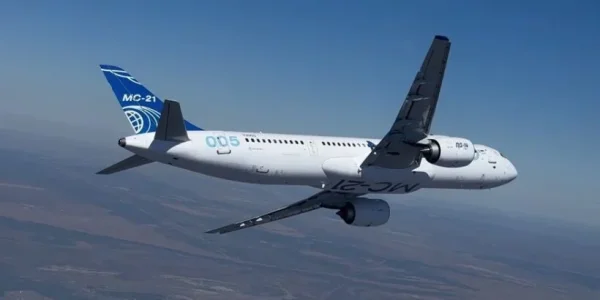
The Ministry of Industry and Trade has announced a competition for experimental design work in order to increase the competitiveness of the PD-14 engine. The R&D work, designed to solve several key problems, is divided into three stages with the work to be completed in December 2027.
The engineers will have to increase the engine life, improve fuel efficiency, reduce weight, achieve additional noise reduction, and optimize production processes to reduce labor intensity and material consumption for manufacturing parts. The Ministry of Industry and Trade will allocate more than 14 billion 230 million rubles for this. It is also necessary to modify the PD-14 based on the results of certification tests of the import-substituted version of the aircraft and the initial stage of operation of the MS-21-310.
* * *
The Yakovlev company has commissioned a pneumatic-frame hangar for a linear maintenance station at Kurumoch Airport (Samara). This hangar has become the largest such structure in Europe. It will provide maintenance for aircraft, including short-haul Superjet 100s, and in the future, medium-haul MS-21-310s. The first aircraft to undergo maintenance will be the SSJ100 of Rossiya Airlines. The aircraft will undergo 4Y-check (periodic maintenance).
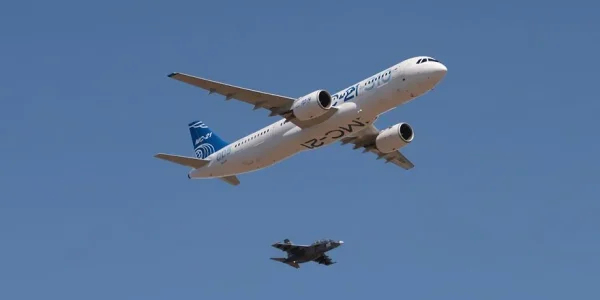
Deputy Minister of Industry and Trade of the Russian Federation Gennady Abramenkov announced in mid-April at a meeting of the Federation Council Committee on Economic Policy that the start of certification flights of the partially import-substituted MS-21 aircraft is expected in the spring of 2025, and the fully Russified version - in the summer. Work on forming the final appearance of the aircraft and ground testing of the systems is being completed. His words were confirmed by the first flight after replacing foreign systems on board 73055 (MS.0012) on April 29. In parallel with this, the installation of systems on machine 73057 (MS.0013), which is completely in an import-substituted appearance, is being completed.
At the same time, work is underway to prepare for serial production. Twelve machines are docked in various stages of readiness, awaiting completion of certification tests and retrofitting with Russian systems. Completion of certification and the start of serial production of the MS-21 are key goals of the Russian aviation industry.
Photo from the Yak-130 escort aircraft. © D. Denisov / Provided by the press service of PJSC "UAC"
The experimental MS-21, flight 73055, arrived in Irkutsk from Zhukovsky on July 7, 2023. During the modification, the inertial navigation system, auxiliary power unit, air conditioning and pressure control systems, lighting equipment, and aircraft system consoles were replaced with domestic ones. A Russian power distribution system and hydraulic system were installed. The chassis was originally Russian-made. Some imported components on this experimental aircraft remained in the avionics complex.
The most difficult and time-consuming task was replacing the power supply system. It took France's Thales seven years to develop a similar


